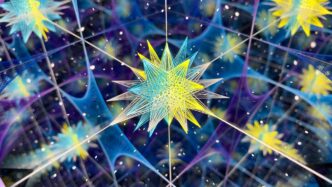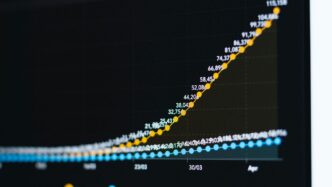The Genesis Of The Many-Worlds Theory
So, back in the 1950s, a young physicist named Hugh Everett III was working on his PhD. He was wrestling with this really weird thing in quantum mechanics called the measurement problem. Basically, quantum stuff can be in multiple states at once – like a coin spinning in the air, being both heads and tails until it lands. But when we actually look at it, it’s always just one or the other. Where did the other possibilities go? It was a puzzle that bugged a lot of smart people.
Hugh Everett’s Academic Foundations
Everett wasn’t just some random guy tinkering in his garage. He got his start at Princeton University, a pretty big deal in the physics world. He was studying under folks who were already deep into the quantum game. He absorbed all the standard ideas, the ones that were pretty much accepted as fact back then. But even with all that solid training, he kept coming back to the measurement problem. It just didn’t sit right with him that reality seemed to change just because someone looked at it.
Mentorship and Early Inquiries At Princeton
At Princeton, Everett had a mentor, John Archibald Wheeler. Wheeler was a big name, and he encouraged Everett to really dig into these tricky questions. Everett wasn’t afraid to question the status quo. He spent a lot of time thinking about the math behind quantum mechanics, specifically how the equations described things evolving over time. He noticed that the math didn’t seem to include any sudden
Challenging Quantum Orthodoxy

So, Hugh Everett III really shook things up, didn’t he? He looked at the standard way of thinking about quantum mechanics, the one most physicists were comfortable with, and basically said, ‘Nah, I don’t think that’s quite right.’ It was a bold move, especially back then.
The Relative State Formulation
Everett’s big idea, his ‘Relative State Formulation,’ was his way of tackling a really tricky problem in quantum mechanics called the measurement problem. You know how in quantum mechanics, a particle can be in multiple states at once, like a coin spinning in the air before it lands? Well, the standard view says that when you measure it, it ‘collapses’ into just one state. Everett thought this collapse was a bit of a cheat. He proposed that instead of collapsing, the universe itself splits. Every possible outcome of a measurement actually happens, just in different, parallel universes. So, if you measure that spinning coin, in one universe it lands heads, and in another, it lands tails. It’s a wild thought, but it gets rid of the need for that mysterious ‘collapse.’
Addressing The Measurement Problem
This whole measurement problem is a headache. The standard interpretation of quantum mechanics has this weird split: there’s the quantum world where things are fuzzy and in superposition, and then there’s the classical world of our everyday experience where things are definite. The measurement process is supposed to bridge this gap, but how it does that is super unclear. Everett’s formulation sidesteps this by saying there’s no actual collapse. The ‘observer’ and the ‘system’ being observed become entangled, and each possible outcome leads to a new, separate state of the observer and the system. It’s like a branching tree of reality, where each branch is a valid outcome.
Quantum Branching And Parallel Realities
What this means is that every quantum event, especially those involving measurement or interaction, causes the universe to branch. Think of it like this:
- Initial State: A quantum system is in a superposition of states.
- Interaction/Measurement: The system interacts with an observer or measuring device.
- Branching: The universe splits. In one branch, the observer sees outcome A, and the system is in state A. In another branch, the observer sees outcome B, and the system is in state B. And so on for all possible outcomes.
This isn’t just some philosophical musing; it’s a direct consequence of applying the quantum mechanical equations consistently, without adding extra rules about collapse. It suggests that the reality we experience is just one thread in an unimaginably vast tapestry of parallel worlds, each one a consequence of a different quantum possibility playing out.
Reception And Later Life Of Hugh Everett III

So, Hugh Everett III drops this bombshell of an idea, the Many-Worlds Theory, and what happens? Well, it wasn’t exactly a ticker-tape parade. The physics world, especially back in the late 50s and 60s, was pretty set in its ways. Think of it like trying to convince your grandpa that his flip phone is obsolete – it’s a tough sell.
Initial Skepticism From The Physics Establishment
When Everett first put his ideas out there, the reaction was… lukewarm, to put it mildly. Most physicists were pretty comfortable with the standard interpretation of quantum mechanics, the one that involves probabilities and the observer collapsing the wave function. Everett’s idea that every possibility actually happens, just in different universes, was a bit too much for many to swallow. It sounded more like science fiction than serious physics. The sheer mind-bending nature of parallel realities made it hard for many to accept as a scientific explanation. It was like, ‘Wait, so every time I make a choice, a whole new universe splits off? That’s wild!’
- The Copenhagen Interpretation: This was the dominant view, and it worked well enough for most. It focused on what we observe, and Everett’s theory seemed to sidestep that in a way that felt uncomfortable.
- Lack of Testability: A big hurdle was how to actually test these other universes. If you can’t see them or interact with them, how do you know they’re there? This made it difficult to prove or disprove.
- Philosophical Objections: Beyond the technicalities, there were philosophical issues. The idea of infinite universes seemed extravagant and, to some, even absurd.
A Career In Defense And Operations Research
After getting his PhD, Everett didn’t stick around in academia to champion his theory. He actually moved into defense and operations research. He worked for a company called DBS Corporation, which sounds pretty serious. He was involved in things like calculating missile trajectories and figuring out the best ways to use resources, which is a far cry from pondering alternate realities. It seems he found the practical applications of math and computing more appealing, or perhaps more financially stable, than the theoretical debates of quantum physics. He even ended up as chairman of DBS Corporation at one point.
Personal Life And Psychological Landscape
Everett’s personal life was, by many accounts, complicated. He had a difficult childhood, with his parents divorcing when he was young. This seemed to affect him, leading to periods of depression and a tendency to keep people at arm’s length. He apparently viewed relationships and interactions as a kind of calculation, trying to figure out the best outcome. It’s a bit sad, really, that someone who came up with such a grand idea about the universe might have struggled with connection in his own life. He also had struggles with addiction, which likely didn’t help matters. Despite his genius, he seemed to carry a lot of personal burdens.
The Enduring Legacy Of Everett’s Interpretation
It’s pretty wild to think about how Hugh Everett III’s ideas, initially met with a shrug, have become such a big deal in physics. His Many-Worlds Theory, which sounds like something straight out of science fiction, is still making waves today. It’s a concept that really challenges how we usually think about quantum mechanics, you know, the whole idea that things can exist in multiple states at once until we look at them. Everett’s take was different; he suggested that instead of collapsing into one state, the universe actually splits, with each possibility playing out in its own separate reality.
Stimulating Debate In Fundamental Physics
Everett’s work really got people talking, and not always in a friendly way at first. The idea of a universe constantly branching off into countless others was a lot to swallow for physicists used to more straightforward explanations. But that’s kind of the point, isn’t it? Sometimes the most mind-bending ideas are the ones that push science forward the most. It’s like he threw a wrench into the gears of quantum orthodoxy, and the debate it sparked is still going strong. Scientists are still wrestling with the implications, trying to figure out what it means for our understanding of reality itself. It’s a testament to the power of a truly original thought.
A Beacon For Challenging The Status Quo
What’s really cool about Everett’s legacy is how it inspires people to question things. He wasn’t afraid to go against the grain, even when it meant facing criticism. His theory is a great example of how a single person’s insight, even if it’s not immediately accepted, can eventually change the way we see the world. It’s a reminder that sometimes the most important discoveries come from those who dare to think differently.
The Many-Worlds Theory’s Growing Influence
Over time, Everett’s interpretation has gained more traction. It’s not just a fringe idea anymore; it’s a serious contender in discussions about quantum mechanics. You see it popping up in different areas of physics, from cosmology to quantum computing. It’s fascinating to see how an idea that was once considered too strange is now influencing new research and sparking new questions. It’s a slow burn, for sure, but the influence is definitely there, growing with each passing year.
Rediscovering Hugh Everett’s Work
It’s funny how some really big ideas just sort of… disappear for a while, isn’t it? That’s kind of what happened with Hugh Everett’s groundbreaking work on the many-worlds interpretation. For years, his ideas were mostly just a whisper in the physics community, something a few people knew about but wasn’t exactly front-page news. It took a while for the world to catch up, and even longer for his contributions to get the spotlight they deserved.
The Basement Treasure Trove
So, how did we even start finding all this stuff again? Well, a lot of it comes down to his family. After Everett passed away, his son, Mark Everett, found a whole bunch of his father’s papers. We’re talking about notes, drafts, correspondence – the whole shebang. It was like finding a hidden stash of scientific history. This collection became the bedrock for understanding Everett’s thought process and the evolution of his ideas. It wasn’t just a few scribbled notes; it was a substantial archive that allowed researchers to piece together the story of the many-worlds theory from the ground up, directly from the source.
Collected Works and Commentary
Once these papers started surfacing, people got really interested. Physicists and historians began digging through them, trying to make sense of it all. This led to the publication of collected works, like the book "The Many Worlds Interpretation of Quantum Mechanics," which brought together Everett’s thesis and other key writings. It wasn’t just about presenting the raw material, though. People started writing commentaries, explaining what Everett was trying to say and why it was so important. It’s like finding an old, complicated map and then having a guide who can actually explain all the weird symbols and hidden paths.
Here’s a look at some of the key materials that resurfaced:
- Everett’s Doctoral Thesis: The original document laying out the relative state formulation.
- Correspondence: Letters exchanged with other physicists, like John Archibald Wheeler and Bryce DeWitt, showing the early discussions and reactions.
- Personal Notes and Drafts: These offer a glimpse into his thinking, showing how he worked through problems and refined his concepts.
Documentaries and Public Recognition
Eventually, the story of Everett and his theory started to reach a wider audience. Documentaries and popular science articles began to appear, explaining the mind-bending concept of parallel universes to people who weren’t necessarily physicists. It’s one thing for academics to discuss it, but seeing it presented in a way that everyday folks can grasp makes a huge difference. This increased visibility helped to solidify Everett’s place in the history of science and brought his unique perspective to the forefront, long after his initial work was done.
A Universe of Possibilities
So, Hugh Everett III’s idea, the one about all those branching worlds, it’s still a big deal. Even though it sounded pretty wild when he first came up with it, a lot of smart people now think it’s a really serious way to look at how the universe works. It’s like he opened a door to thinking about reality in a totally new way. His work makes us question what we think we know and keeps physicists and thinkers busy trying to figure it all out. It’s a good reminder that sometimes the most out-there ideas can end up being the most important ones, pushing us to explore the big questions about everything. Everett’s legacy is definitely still with us, making us look at the cosmos with a bit more wonder.














